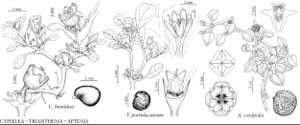Difference between revisions of "Aptenia cordifolia"
Gartenflora, 57: 69. 1928.
Common names: Baby sun-rose
IntroducedIllustrated
Basionym: Mesembryanthemum cordifolium Linnaeus f. Suppl. Pl., 260. 1782
imported>Volume Importer |
imported>Volume Importer |
||
| Line 60: | Line 60: | ||
|publication year=1928 | |publication year=1928 | ||
|special status=Introduced;Illustrated | |special status=Introduced;Illustrated | ||
| − | |source xml=https:// | + | |source xml=https://bitbucket.org/aafc-mbb/fna-data-curation/src/2e0870ddd59836b60bcf96646a41e87ea5a5943a/coarse_grained_fna_xml/V4/V4_173.xml |
|genus=Aptenia | |genus=Aptenia | ||
|species=Aptenia cordifolia | |species=Aptenia cordifolia | ||
Latest revision as of 21:57, 5 November 2020
Plants short-lived. Stems 3–6 dm; internodes 1–5 cm; often rooting at nodes. Leaf blades 1–3 × 0.5–5 cm, minutely papillate, appearing smooth. Inflorescences solitary flowers; axillary pedicel 8–15 mm. Flowers: hypanthium 6–7 mm; calyx lobes 2–5 mm; petals 80, reflexed, pink to purple (red in hybrid cultivar “Red Apple”), 3–4 mm; staminodia 50, erect, white, 3 mm. Capsules 13–15 mm. 2n = 18.
Phenology: Flowering spring–fall.
Habitat: Disturbed places, coastal bluffs, margins of coastal wetlands, 0-100 m
Distribution

Introduced; Calif., Oreg., Europe (British Isles), Africa, Australia.
Discussion
The flowers of Aptenia cordifolia open during the bright hours of the day.
Selected References
None.
Lower Taxa
None.
